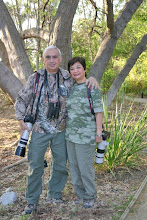Finally recovering from the adrenalin rush better known as the Dumaguete trip, Cynthia and I inserted a birding trip in between typhoons.
Our friend Boboy Francisco took us inside the Beverly Hills subdivision in Antipolo and acted as our birding guide. Gray skies and an abbreviated sortie did not yield the species we hoped to find.
We started off by meeting Henry Calilung, a biologist from the University of the Philippines and his band of young volunteers, including Boboy's daughter, Moira. Henry and company were doing a monthly mist netting of the birds found in the subdivision for census and DNA analysis purposes. They haven't caught anything yet when we met them early that morning but when we saw them again after our birding sortie, he informed me that they just caught a Mangrove Blue Flycatcher.
Birding the forested areas of Beverly Hills yielded nothing much except Brown Shrikes which can be seen every 500 meters or so. Every so often we would catch glimpses of a large brown birds - at different places. We presumed them to be cuckoos of some sort. One of those was a bigger than most skulker which Boboy concluded to be a Scale-feathered Malkoha. Too bad it didn't show itself even when we waited patiently and motionlessly for a good 15 minutes.
What was rather common were the munias. They were just everywhere! The Scaly-breasteds were feasting on the fruiting grass stalks while the White-bellieds were surprisingly up in the trees.
A puzzle was an active brownish olive bird which was busily hunting for insects. For now, I would say that it was an Arctic Warbler although I hope that it would be one of those less common species.
Finishing the loop in about two hours, we were all sweating from the humidity and from the strain of walking the undulating roads of this subdivision. We bade Boboy goodbye and assured him that we will be back and try our luck once more. Maybe when the rains finally stopped coming.
Old school birding...
18 hours ago






No comments:
Post a Comment